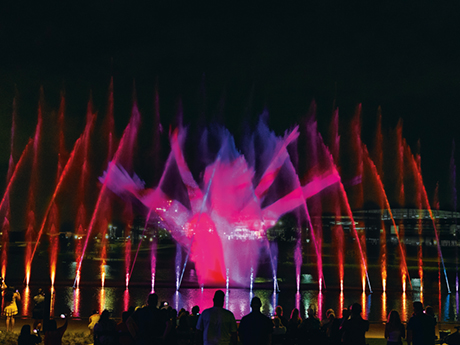By J. Wickam Zimmerman, CEO, Outside The Lines Inc.
The use of artificial intelligence (AI) technology is growing in retail commerce, where it’s already helping businesses track inventory, forecast demand and suggest new products to consumers.
But how does AI figure into retail real estate? Can it be used to enhance engagement and drive success at the properties themselves? Could it help entice shoppers to step away from their online shopping carts and venture out into the real world?
The answer is a resounding yes, and we’re already seeing this play out in the Lone Star State.

Creating Spaces That Attract & Retain
With major Texas markets like Dallas-Fort Worth and San Antonio seeing record-high retail occupancy rates, many property owners are focused on capitalizing on this momentum. To keep foot traffic high and remain competitive with other local developments and online shopping, it’s more important than ever to create unique draws to centers.
A key strategy involves creative placemaking and offering experiential destinations that are increasingly bolstered by technology, including AI. To stay ahead, retail centers today must offer an experience that can’t be replicated virtually. This requires having dynamic, interactive onsite features and leveraging technologies that are just now becoming widely available.
One such technology is Aquarius Interactive, an AI software that can be applied to water features to turn them into interactive elements, enhancing their ability to entertain and engage. In simple terms, it captures the movements of audience members and mimics them — when someone reaches an arm up or jumps to the side, the water and the lights respond.
The technology doesn’t require participants to hold a device or step on a pressure sensor or engage with any other physical objects. In fact, the participants will not even know that Aquarius Interactive is present until it starts reacting to their presence and draws them into the interaction.
This technology was created by Outside The Lines to fascinate and excite those who visit these water features, which are often components of retail and mixed-use centers. In the last two years, the capabilities have already changed, grown and revealed themselves in tremendous ways.
One Technology, Many Applications
A key characteristic of AI is that it learns and improves at a rapid pace. Developers, owners, designers, tenants and other stakeholders of commercial properties are quickly realizing its capabilities to do so much more than originally understood.
For example, Aquarius Interactive includes cameras that capture what’s in their field of view, whether that is in front of the fountain, in a gathering place or elsewhere — think height and dimensions of the person standing in front of it. This way, the water and lights will react differently when someone stands in front of it and points his or her arm instead of foot.
Through research and continued implementation and use, the technology is constantly being fine-tuned to make it more precise, because the faster and more accurately it reacts to audience movement, the more fun it is for the viewer to interact with.
As the technology has grown and changed over the last two years, it’s become clear that there are other ways it could be used to help retail and mixed-use properties flourish.
Because it’s capturing thousands of data points and translating them into reactions of the water, light, fog or anything controlled by Digital Multiplex (DMX, the standard protocol for controlling effect devices) the technology could also theoretically capture demographics. Because it mimics human motion, perhaps it could also guide movement.
This AI technology can also be used to gather information. From reporting foot traffic at a center throughout various times of the day to quantifying how much time shoppers spend at various locations throughout a property, there are many useful applications for owners and operators of brick-and-mortar real estate.
With sequential lighting or projection mapping, this same technology could be used like a breadcrumb trail to lead a shopper to a particular point of interest, such as a new retail store’s front door or a holiday light display.
The technology could also facilitate an interactive maze with lights, sounds, fog and water that could change and adapt to the participant’s speed and accuracy. It could create an interactive chase-and-follow program to bring attention to a specific site on a retail property or to lead shoppers to a display that they otherwise might never find.
The Time is Now
Innovative and engaging features utilizing AI that not only draw traffic but also extend potential customers’ time at properties are already up and running throughout the country. The common thread among the various applications is that they contribute to increased time and money spent in the surrounding shops and restaurants.
One example of this is the Illuvia fountain at EpicCentral in Grand Prairie, which is known for its nightly water, light and music video shows. Through incorporating AI, the components of the fountain can work together in new ways and create a unique experience each night.
As technology advances, applications like Aquarius Interactive are becoming increasingly compatible and simple to implement into existing features. These platforms can be easily adapted to any DMX-controlled projects, which is standard protocol for water features and show lights. The equipment is minimal — just a server, which most show features already have — as well as one or multiple cameras connected via ethernet cables.
From there, the possibilities are practically endless.
The Future of AI in Retail
There are seemingly countless and creative ways we can teach AI to help design and build entertaining features to engage customers. The technology is evolving every day, and developers and property owners who are on the cutting edge will ultimately find the best ways to use it to their advantage.
For now, we see creative placemaking and experiential retail as the ideal way to bring consumer foot traffic to retail properties.
Commercial property developers, owners and managers are still just scratching the surface of what we can do with this AI technology, and we can’t wait to see how it evolves and what the future will bring.
J. Wickham Zimmerman is the CEO of Outside the Lines, Inc., a design-build themed construction company that specializes in creating one-of-a-kind rockwork, water features and themed environments for retail entertainment, hospitality, gaming and golf properties around the globe.


